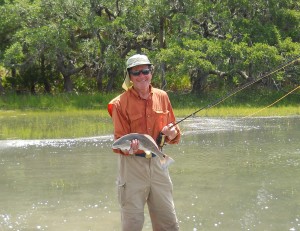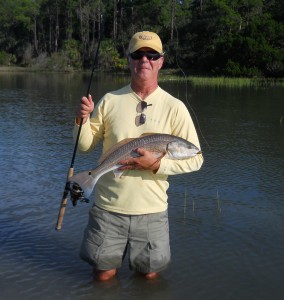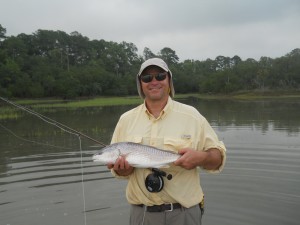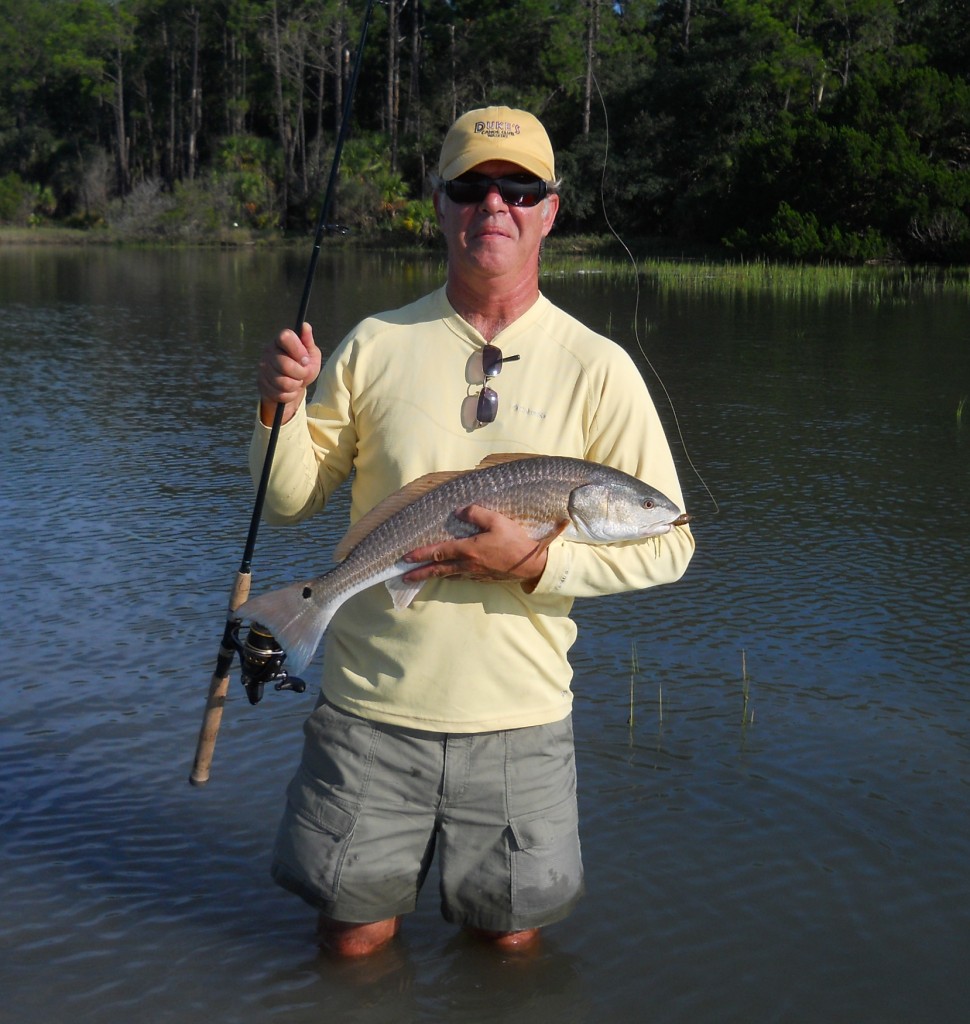Tailing Redfish
By Capt. Charlie Beadon
 Fishing for tailing redfish has got to be one of the most exciting ways to catch fish in the Lowcountry; possibly in all of shallow water fishing. This type of fishing combines all fishing skills plus it is very similar to hunting in the way that you stalk the fish. Picture this; you’re on a pristine short grass flat, the water is rising and in the distance you hear water splashing and fish crashing around. As the water rises the splashing gets closer and closer until you look in the distance and see rings of water moving outward form a copper-blue tinged tail. Then another and another, and you realize that you’re in the middle of a hot tailing bite. The only question is can you keep a steady casting hand as your heart races harder with every tail that pops up. This is fishing for tailing reds.
Fishing for tailing redfish has got to be one of the most exciting ways to catch fish in the Lowcountry; possibly in all of shallow water fishing. This type of fishing combines all fishing skills plus it is very similar to hunting in the way that you stalk the fish. Picture this; you’re on a pristine short grass flat, the water is rising and in the distance you hear water splashing and fish crashing around. As the water rises the splashing gets closer and closer until you look in the distance and see rings of water moving outward form a copper-blue tinged tail. Then another and another, and you realize that you’re in the middle of a hot tailing bite. The only question is can you keep a steady casting hand as your heart races harder with every tail that pops up. This is fishing for tailing reds.
What is a tailing fish? A tailing fish is a fish that exposes its tail during the course of feeding or while moving form one place to another. Other inshore fish such as bonefish and permit tail for the same reasons as redfish. Many offshore fish tail as they surf down large swells. In fact, we look for specific offshore “tailing” conditions where sailfish, cobia and even mahi-mahi will tail. In this area we have a great fishery for red drum, and reds are notorious for tailing as they feed on the bottom. If you look at the mouth of a redfish it faces downward, this is specifically for feeding on the bottom. Redfish don’t feed exclusively feed on the bottom but they do when picking up dead baits and especially crab and shrimp. The main reason that redfish push up onto our local flats is to feed on fiddler crabs, which are on the bottom, which in turn causes the fish to expose their tails as they feed in shallow water.
 The equipment needed when fishing for tailing reds is a brimmed hat, polarized sunglasses, a good rod and reel combo lined with 8-12 lb test monofilament line or similar braid. There are a whole host of good baits for redfish. Live shrimp and mullet work well. If you prefer lures I would go with gulp baits, screw tails, jerk baits, spoons, or even top water poppers. As with all saltwater fish I use a monofilament leader. For redfish I use either 20 or 30 lb leader joined to the main line with a bimini twist and back to back uni-knot combination. A few other items that may come in handy are a pair of wading shoes (an old pair of tennis shoes work well), a fanny-pack tackle box and a flow-well for live bait fishing.
The equipment needed when fishing for tailing reds is a brimmed hat, polarized sunglasses, a good rod and reel combo lined with 8-12 lb test monofilament line or similar braid. There are a whole host of good baits for redfish. Live shrimp and mullet work well. If you prefer lures I would go with gulp baits, screw tails, jerk baits, spoons, or even top water poppers. As with all saltwater fish I use a monofilament leader. For redfish I use either 20 or 30 lb leader joined to the main line with a bimini twist and back to back uni-knot combination. A few other items that may come in handy are a pair of wading shoes (an old pair of tennis shoes work well), a fanny-pack tackle box and a flow-well for live bait fishing.
There are very specific conditions that need to come together in order for redfish to move onto a flat and feed. First, you need to find hard sand flats that have short grass and fiddler crabs. I like to look for flats close to open water where the fish don’t have to move far from their normal activities to get onto the short grass flats. You also need to find flats where there are good numbers of fish close by to begin with. There are numerous good flats that could support redfish but don’t because there is not a local population of fish near that area. Once the fish move onto the flat I have noticed that they move in with the tide but stay relatively close to the tall grass. The fish also move off of the flat quickly when the tide starts to recede as should you to keep from getting stranded. The major factor when looking for tailing flats is the tide. You need a full or new moon high incoming tide to have enough water on the flats to support fish.
 There are two major techniques used to fish for tailing redfish. The first is out of a boat using a poling platform and push pole and the next is wade fishing. The only advantage to using a boat here is that you don’t get your feet wet. By all means wade fishing is the way to go when fishing for tailing reds. In either case, working the tailing flats requires a good eye. This is sight fishing at its best, a good hat and polarized glasses are a must. Generally, when the fish start tailing you want to look for a fish that is actively feeding and stalk the fish. I’ve watched the same fish feed for over 15 minuets until I took the right shot. A good cast is a must; realistically you need to be able to accurately cast 40-50 feet of line to have a shot at these fish. You want to place the bait about 4-5 feet in front of the fish and move it when the fish pops its head out of the sand. These fish also respond to scent so bait such as a Berkley Gulp will increase your chances of hooking up.
There are two major techniques used to fish for tailing redfish. The first is out of a boat using a poling platform and push pole and the next is wade fishing. The only advantage to using a boat here is that you don’t get your feet wet. By all means wade fishing is the way to go when fishing for tailing reds. In either case, working the tailing flats requires a good eye. This is sight fishing at its best, a good hat and polarized glasses are a must. Generally, when the fish start tailing you want to look for a fish that is actively feeding and stalk the fish. I’ve watched the same fish feed for over 15 minuets until I took the right shot. A good cast is a must; realistically you need to be able to accurately cast 40-50 feet of line to have a shot at these fish. You want to place the bait about 4-5 feet in front of the fish and move it when the fish pops its head out of the sand. These fish also respond to scent so bait such as a Berkley Gulp will increase your chances of hooking up.
Tailing conditions are prime for fly fisherman. An 8-9 wt. rod, matching reel and 150-200 yards of backing toped with floating line will be good for these fish. A few flies that I would recommend are the clouser minnow, deceivers, sliders and crab patterns. In general, redfish prefer white, brown, copper and gold. Good luck and tight lines.
Captain Charlie Beadon
www.hiltonheadfishingadventures.com

